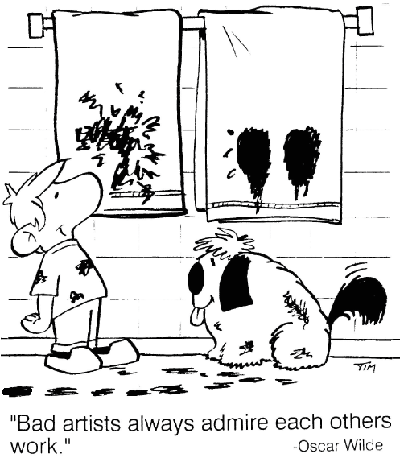|
 |
| Teachers.Net Gazette Vol.6 No.2 | February 2009 |
Subscribe for free home delivery |
|
Can Anyone Learn to Draw? | |
| by Tim Newlin Regular contributor to the Gazette February 1, 2009 |
|
|
 The truth is that anyone can learn to draw and “drawing talent” is not something that can be inherited – it is a symphony stimulated by social or family encouragement using whatever genetic tools we choose to exercise in order to put ideas, thoughts, and feelings into a visual image. A brain that learns to observe when it is young grows visual neurons that other brains lack. This is why we have a common misconception that drawing is an inherited talent. It's true that the drawing brain is different, but the difference has been learned and the brain has developed in response to being needed in these particular ways. When this happens at a young age, the child appears to have inherited talent. It is now known that adult brains can also grow new neurons and develop new talents, but it is slower and the process is more difficult. Adults often lose the love of learning for its own sake. Young children find learning simple tasks to be new and fascinating. The classic understanding of “drawing” is the application of paint, ink or graphite to a surface using well trained hand-eye movements. But technology has changed this. Today, people who cannot even draw stick figures can, with the aid of technology, create beautiful images or funny cartoons with well defined characters and recognizable objects. In short, they can communicate feelings and ideas with beautiful images even though they may not be able to “draw”. Why is this? The answer is because they can see in their minds the image they want to create – how that image is made physical for others to see is a matter of choice. Some put pen or pencil to paper, others use pixels and programs. But the end result is aiming at the same thing. The classic definition of “drawing” requires hand-eye coordination. A person has to have a liking for the feeling of putting a pen or pencil to paper and seeing lines turn into images. People who use computers to do this must be proficient with graphic programs and enjoy the digital media. But both share the ability to “see” what it is they want to create. To the untrained observer, watching either process seems almost magical. People who create drawings, whether digital or by hand, usually are people who are visual thinkers. Most of us think in words and concepts, but recent research has shown that visual thinkers make up about 10-15% of the population. There is no either or – it is more a sliding scale. People who think in words can also think in pictures and vice versa. And awareness as well as training can improve anyone’s abilities in either direction. It all depends on desire and motivation. Thinking in pictures is not the only genetic trait which can help people to draw. Depth perception and an understanding of size and distance, ability to distinguish colors and tones, and hand muscle coordination can all have positive influences. But any or all of these traits will go untapped unless the person has the desire to communicate visually and is motivated to do so by family, or friends, or simply the due to their frustration of not being able to express themselves with words. The “natural born artist” is a myth. Even the best of them needed the motivation and desire as well as the training and time. And even non-visual thinkers can, with perceptual training techniques, vastly improve their visual mental skills as well as their hand-eye or digital abilities. There are no drawings or paintings or digital images in books, films or galleries that are the result of a “god-given talent”. They are all the result of a desire to communicate motivated by a need to express, and most of all, the result of training and a lot of hard work.
Submit your drawings to the new drawing site at www.timtim.com!
Tim Newlin's latest children's book on Scribd:
Tim Newlin
| |
|


 TIMTIM.COM is a free-use site of thousands of color and B&W cartoon-style drawings organized by more than 50 different subjects ranging from holidays, jobs, nature, animals, transportation, computers, religion, environment, health, travel, geography and more. The site is recommended by the American and Canadian Teachers Federation and use of the drawings is free for non-commercial purposes.
TIMTIM.COM is a free-use site of thousands of color and B&W cartoon-style drawings organized by more than 50 different subjects ranging from holidays, jobs, nature, animals, transportation, computers, religion, environment, health, travel, geography and more. The site is recommended by the American and Canadian Teachers Federation and use of the drawings is free for non-commercial purposes.